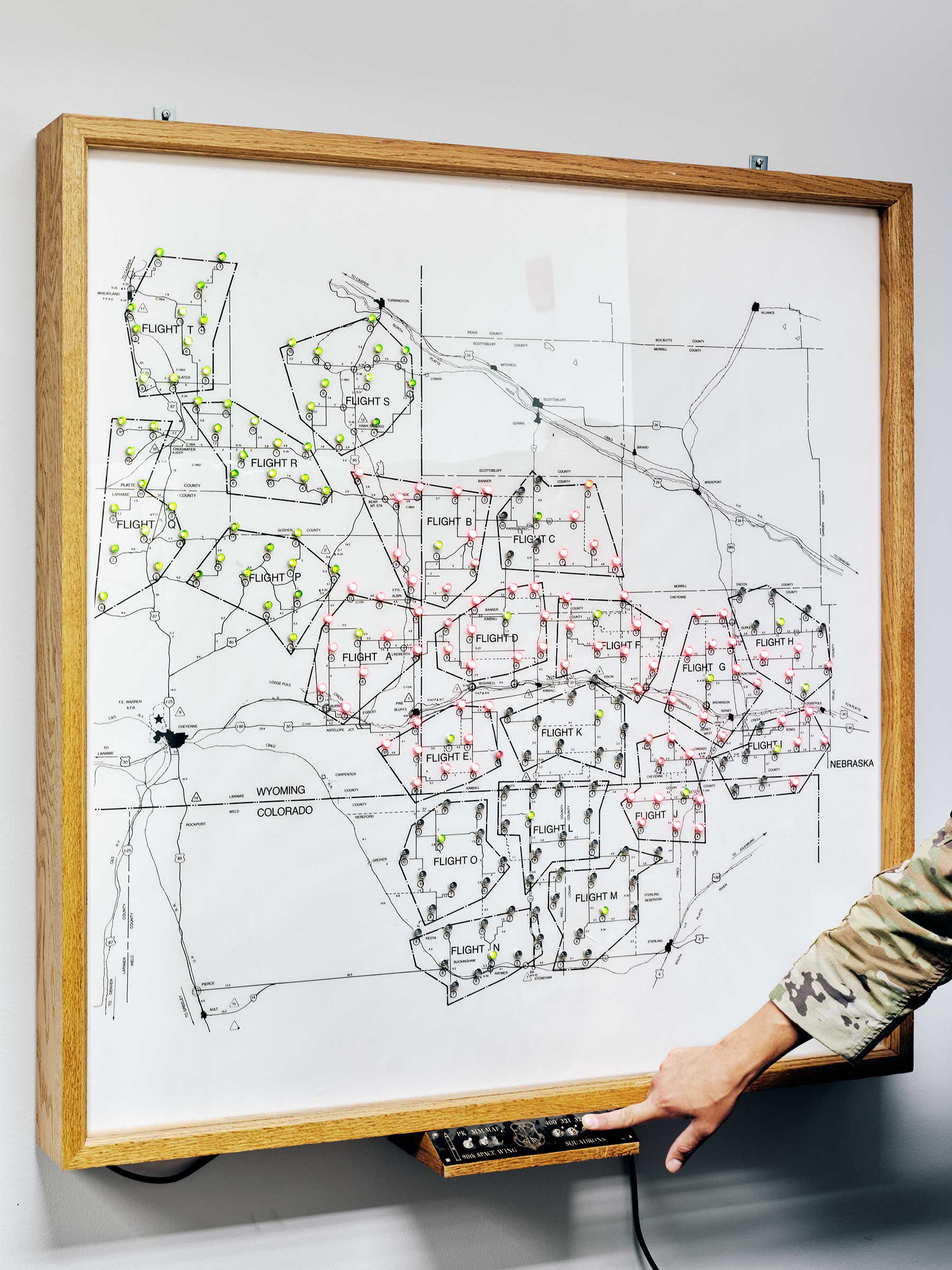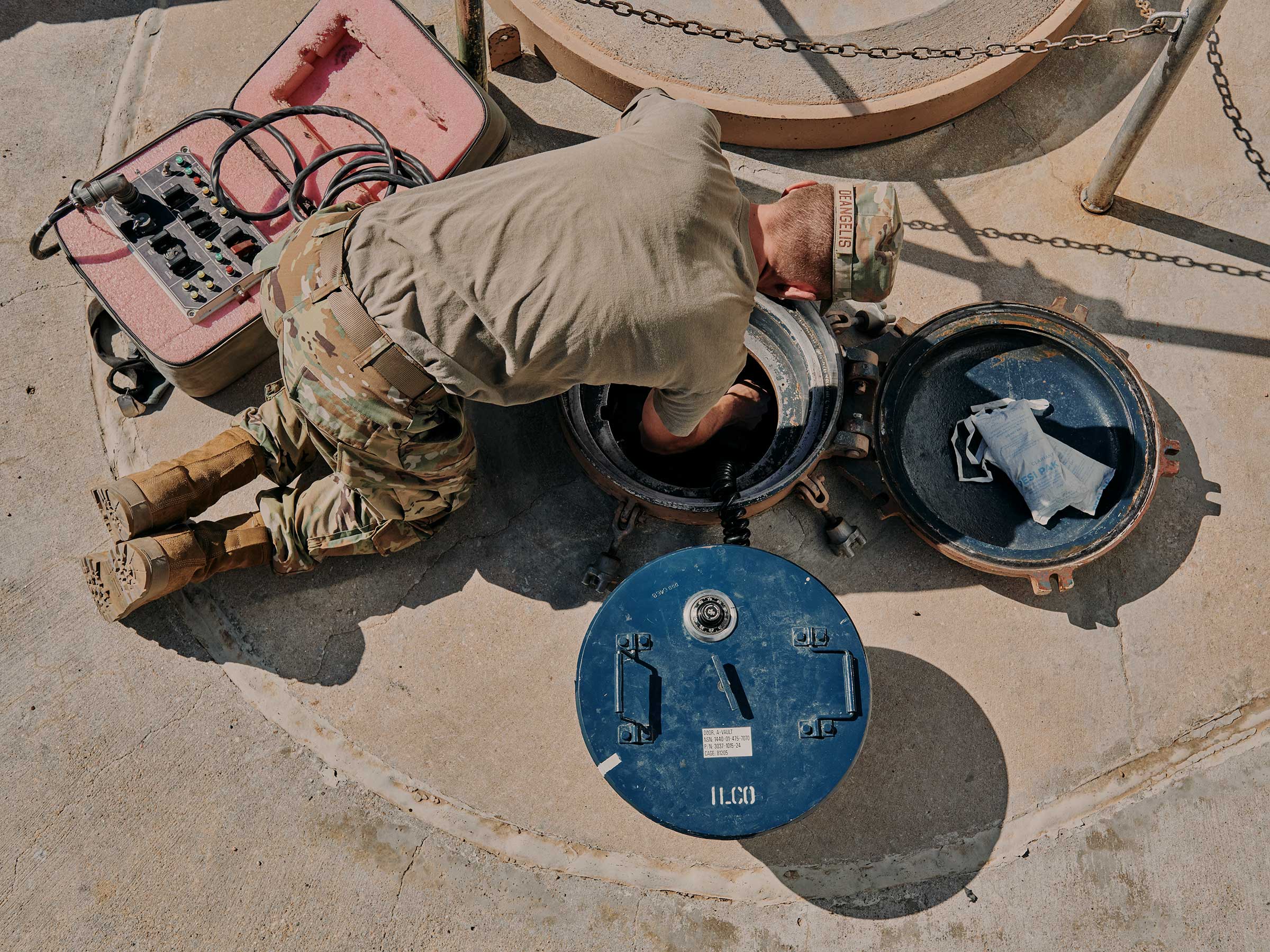If a piece of equipment breaks inside Captain Kaz “Dexter” Moffett’s underground command center at the Alpha-01 Missile Alert Facility, it’s marked with a paper tag that reads either “warning” or “danger.” A few of those are hanging in this cramped capsule buried about 70 ft. below the high plains of eastern Wyoming. One is stuck to the shut-off valves that control water flow in the event of an emergency. There’s another one on a ventilation hatch. The entire command capsule itself is jury-rigged on top of steel stilts because the shock-absorber system, which was first installed in 1963 to survive a thermonuclear blast, is now inoperative. So there’s a tag for Air Force maintenance teams to fix that too.
Then there are malfunctions that aren’t marked. Moffett’s computer monitor—the one that enables him to keep watch on a fleet of 10 nuclear-tipped intercontinental ballistic missiles (ICBMs)—has a flashing glitch on the bottom of the screen. His classified phone line has such a weak connection that he can barely hear fellow Air Force officers who are commanding more than 100 other nuclear missiles spread across 9,600 sq. mi. “You can hear them pretty clearly if you stand on an angle, on one leg, and jump up and down,” Moffett says, smiling. “It’s all part of the job. We spend a lot of time saying to ourselves, ‘Hey, how are we going to make this work today?’”
Walking into Moffett’s capsule at Alpha-01 is like walking into the past. Banks of turquoise electronics racks, industrial cables, and analog controls have been down here since the U.S. military installed the equipment decades ago. Look closely at the machines and you’ll find names of manufacturers like Radio Corp. of America, defunct since 1987, and Hughes Aircraft Co., defunct since 1997. Some systems have been updated over the years, but these advances are unrecognizable to anyone who lived through the personal-computer revolution, let alone the internet age. The entire ICBM fleet runs on less computational power than what’s now found inside the smartphone in your pocket. When something breaks, the Air Force maintenance crews pull parts from warehouse shelves, pay a contractor to make them to specifications, or even occasionally scavenge them from military museums.
If an order ever came for Moffett, 29, to unleash the missiles under his command, the directive—which only a U.S. President can give—would come in the form of what’s called an Emergency Action Message. The order would appear on Moffett’s glitching trichromatic monitor via a computer program that still relies on floppy disks, initiating a series of steps to launch the missiles. A terminal countdown sequence would begin after a machine translated the digital signal from the command hub into an analog signal that the 50-year-old receiver inside a missile silo could recognize. “I never saw equipment like this in my life until I came down here,” says Lieutenant Jessica Fileas, 32, another Air Force missileer and Moffett’s shift partner on the day’s 24-hour alert. “It’s unique.”


For a generation, the U.S. “triad” of nuclear-capable bombers, submarines, and ICBMs has inched toward obsolescence as the nation focused on other pressing security threats like terrorism and cyberattacks. Today these Cold War weapons are years beyond their intended service lives, resulting in exhaustive maintenance shifts and dwindling supplies of spare parts.
That leaves the U.S. facing unappealing choices. It can keep the current fleet, but at increasing cost—the price of ICBM maintenance alone has risen 17% over the past half-decade, to nearly $482 million per year. It can retire some of its nuclear forces, potentially upsetting the global strategic balance that is designed to ensure that if any one country starts a nuclear war, all will be annihilated in it. What the Pentagon wants to do is spend an estimated $1 trillion or more in the coming decades to replace all three legs of the triad.
President Joe Biden came into office seeking to reduce the role of nuclear weapons in American policy. Biden even considered eliminating the ICBM leg of the triad altogether. But that option was scrapped last year, once intelligence agencies determined China was expanding its nuclear-weapons stockpile faster and more aggressively than previously expected. “When you are watching China increase rapidly, looking to triple the number of weapons it has, it did not seem appropriate for the U.S. to unilaterally seek to decrease at this point in time,” an Administration official tells TIME. The view was reinforced after Russia’s invasion of Ukraine, during which President Vladimir Putin has threatened to use nukes against the U.S. and European allies.
Skeptics still ask whether the U.S. military needs to replace each bomber, submarine, and missile to modernize an arsenal conceived to win the Cold War. And if it does, has the nation seriously contemplated the strategic and financial costs of committing another generation to do so? “Americans have forgotten about the inherent danger of nuclear weapons,” says Lindi Kirkbride, 73, a Wyoming activist who led demonstrations in the 1980s against the military’s last attempt to replace ICBMs. “Younger people don’t seem to realize these weapons pose the same existential threat to the world as global warming.”

If the U.S. does decide it needs to keep its land-based missiles, then it should fund a new weapon rather than continuing to plow billions into the existing fleet, says Chuck Hagel, a former Secretary of Defense and Republican Senator from Nebraska. “The nation needs to either replace these systems or do away with them,” Hagel says.
The final decision over whether and how to replace America’s aging nuclear forces lies with Congress. With Biden now on board, the Pentagon is betting it will get all of its $1 trillion plan to replace all three legs of the triad, including $100 billion to replace all land-based ICBMs. In April, Air Force representatives held the first in a series of town halls to let affected communities know what might be coming. The dizzying, decades-long undertaking, now in its first stages, promises to be one of the most complicated and expensive in military history. It involves digging up and removing 450 missiles and 45 command hubs in Wyoming, Nebraska, Colorado, Montana, and North Dakota; paying off as many as 9,800 landowners across 193,000 acres for the right to do so; then building and installing new equipment in its place. Not only does the military plan to swap out all the missiles, silos, and launch centers, but it also intends to rip out and replace the vast underground network of pressurized cables connecting these structures.
For now, the current ICBMs, called Minuteman IIIs, sit buried inside hardened silos at several-mile intervals across the Great Plains. Behind 8-ft. razor-wire fences in wheat fields, cattle pastures, and off-farm roads, 400 missiles are on hair-trigger alert—ready for blastoff—every moment of the day.

Maintenance crews at F.E. Warren Air Force Base in Cheyenne often begin their shifts before dawn. The facilities they visit can be 100 miles or more from base, and it takes a while for the work trucks to haul out there in the snow or rain, especially if that day’s cargo includes a hydrogen bomb. One Tuesday morning in July, the mission is to reinstall a Minuteman III at a missile silo in Pine Bluffs, Wyo. The armed convoy drives east through miles of flat, open landscape dotted with occasional farm buildings or herds of black steers. Drivers crane their necks as the line of military vehicles zoom by.
After an hour on the road, the convoy pulls to a stop on a gravel road off Wyoming Highway 215. If you didn’t know what you were looking for, you’d likely pass Launch Facility A-05 without paying it any mind. It’s a fenced-off area with some antennas, a slab of concrete on rails, and a few other public-utility features. But under the slab rests the most advanced land-based nuclear missile in the U.S. arsenal—at least it will after Technical Sergeant Brian “Fish” Fiscella, 42, and his team install it.
The Air Force maintenance crew pushes through the padlocked fence, drives to a ground hatch on one side of the slab, and uses a hand-operated screw jack to tug open the 2,000-lb. lid. Once it’s pulled away, a team member dials combination codes into two inner lids to gain access. One by one, they crawl down a ladder inside the 42-in.-diameter underground shaft. It’s a two-story climb to a maintenance floor where halogen lights glow above whirring machines along the rounded walls. The Minuteman III goes into the launch tube in the middle of it all, pointing skyward, capable of delivering a nuclear strike to any spot on the planet in roughly 30 minutes. More than 5 ft. in diameter and 60 ft. tall, the ICBM is tipped with a thermonuclear warhead inside its black nose cone that contains a destructive force at least 20 times that of the atomic bomb that killed 140,000 people at Hiroshima.
Fiscella and his team don’t spend time thinking about that. On this day, two of the unit’s missiles are down for maintenance. They need to get this ICBM back online. Besides, they’ve spent hundreds of hours working in underground silos like this, removing and replacing truckloads of parts to ensure the 52-year-old weapon will launch if the order is ever given. The job involves maneuvering a 200-lb. work cage around the missile and parsing technical manuals thick as phone books as though they were religious texts. Every task is standardized.

The men begin hauling out wrenches, lug nuts, harnesses, and winches from black duffel bags as another team above ground starts to roll back the 110-ton launch door overhead. A modified tractor trailer carrying the towering missile slowly begins tilting upward, to position it over the hole once the steel and concrete door is moved out of the way. It is not a slick, seamless task. It involves sweat and heavy tools; progress is measured in inches. The technical manuals are referenced to ensure the work is being properly carried out.
The A-05 site was built in October 1963, at the same time as nine other missile silos and Fileas’ and Moffett’s launch-control capsule. Just like that capsule, much of the equipment down here remains the same. Ventilation keeps the silo at 70°F, a respite from the summer heat outside, with controlled humidity to keep all the machinery operating properly.
Suddenly, everything in the silo goes dark. Standing underground next to one of the world’s most powerful weapons during an unexpected blackout is unnerving, but the Air Force maintenance team is unmoved. It’s the sort of thing they’ve come to expect working with this equipment. They wait for power to surge through a distribution panel that was manufactured decades before any of them were born. In the darkness, they debate whether commercial power or an on-site generator will kick in first. “The power will come back on, just give it a second,” Fiscella says. “A lot of this stuff is dated and old. It breaks.”
Indeed. A roof once sprang a leak inside the high bay hangar where Air Force personnel handle the W78 and W87 thermonuclear warheads. Crews last winter had to cut through the rusted locks of the heavy launch door above an armed Minuteman III and lower two maintainers into the launch tube to repair it, using a harness and crane. Teams battle corrosion, water intrusion, collapsed conduits, misaligned doors, and bulging walls. There are hundreds of thousands of components to the Minuteman III, and something is always breaking.
On average, maintenance teams in Wyoming replace five parts a day, every day. Sometimes when a part fails, it can be found in military stock. Other times, an electrical adapter or connector gives out, and it’s been decades since anyone has seen one. The Air Force can’t simply pull something off the shelves at Home Depot and slap it on a nuclear missile, so entire teams are dedicated to locating spare parts. If it can’t be found, the military will contract a machine shop to manufacture it from original specifications, which can be pricey. Maintenance expenses have ballooned to $55,000 an hour for missiles and equipment held year-round in temperature-controlled silos buried deep underground.



The proposed new ICBM, known as the Ground-Based Strategic Deterrent until the Air Force formally named it the Sentinel in April, will include improved rocket boosters, composite materials, and new guidance systems, according to the military. It will also use an open architecture design, enabling software upgrades and other updates without requiring a complete overhaul. Air Force commanders say it’s an easier, less expensive way to support the missile’s intended 50-year life cycle than pulling the missile apart by hand or painstaking nose-to-tail refurbishments.
Air Force and Army Corps of Engineers personnel have already started fanning out across Wyoming to draw up environmental-impact studies, rights of entry, and other plans related to construction. Initial work will begin in Wyoming missile fields in 2024. As plans coalesce and more workers flow in, major construction on the silos and control centers will start in 2026. Crews then aim to open a new silo every week for nine straight years. In the meantime, the Sentinel missile is set for its first test flight next year from Vandenberg Space Force Base in California.
Back inside the silo, it takes about 90 seconds before the lights flicker on and machines blink back to life. “All right, back to work,” Fiscella tells the crew. “We’re going to be behind schedule.”


From her front yard, Mato Winyun can see the Air Force team working at Launch Facility A-05, but doesn’t know what they are doing. She lives a half-mile down the road in a one-story white farmhouse tucked behind a row of bushes and evergreen trees. The towering missile stands upright against the afternoon sky. “I don’t ask any questions, but it seems important,” says Winyun, 81, her white hair twisted in two braids in keeping with her Lakota heritage.
Like many of her neighbors, Winyun doesn’t expect the Minuteman III to ever climb out of the wheat fields on a column of rocket fire. But it’s programmed to trace a fiery arc to about 70 miles above earth, shedding three different rocket stages within three minutes. In outer space, far from Winyun’s view, a cone-shaped re-entry vehicle and the thermonuclear warhead inside would maneuver toward its target at around 15,000 m.p.h. Navigation relies on an inertial guidance system with spinning gyroscopes—not satellite signals. If it’s even .05% off, it could mean a difference of 20 miles or more.
The re-entry vehicle would spin clockwise and fall through the earth’s atmosphere at speeds several times faster than a rifle bullet. Less than a minute later, the hydrogen bomb would detonate a few hundred yards above ground zero, generating a miles-long fireball with temperatures reaching millions of degrees. It would incinerate any person or building within a half-mile. Shock waves would level structures for miles. Residual fallout would rain down for days, contaminating the environment, water, and food supplies, inflicting health problems for any survivors. Casualties would be measured in the millions.
That’s a mission that nobody wants to see. And yet, the nation needs these ICBMs, Pentagon and U.S. military leaders say, to deter Russia, China, North Korea, or any other nation from ever thinking about launching a preemptive attack on the U.S. In the macabre logic of nuclear war planning, those nations are restrained from doing so out of fear that the Minuteman IIIs will unleash their own destruction. It is also why the U.S. needs to replace the aging missiles, Biden and the Defense Department brass have concluded, rather than continuing the struggle to sustain the current system.
Critics say this thinking is antiquated Cold War dogma. The thermonuclear missiles carried on submarines and long-range bombers are more than enough to dissuade hostile nations from reaching for their own nukes, they say. What’s more, they worry, ICBMs could trigger an inadvertent nuclear disaster through a faulty launch warning, an adversary’s miscalculation over U.S. intentions, or some other blunder. There were multiple near misses during the Cold War, when the annihilation of much of the human race was averted thanks only to luck or the common sense of a low-level officer. In February, the Pentagon postponed a long-planned ICBM test launch to avoid escalating tensions with Russia amid its war in Ukraine. Antinuclear groups call that kind of precarious circumstance evidence that perhaps the weapons should be scrapped altogether.

Another aspect of the silos that isn’t widely discussed in America’s heartland is that they’re a kind of strategic bait for other nations’ nuclear strikes. Nuclear “counterforce strategy” emphasizes the pre-emptive destruction of an adversary’s nuclear weapons before they can be launched. The U.S. military has seized upon this idea as a justification for building new ICBMs. The thinking goes that if the U.S. didn’t have land-based missiles, Russia or China could simply launch an all-out attack on just six U.S. strategic targets: the seat of government in Washington, three nuclear-bomber bases (in North Dakota, Missouri, and Louisiana), and two nuclear-submarine ports (in Washington State and Georgia). “The target set expands from six major targets to well over 400 targets with the ICBM-based leg,” says Air Force General Anthony Cotton, who commands the branch’s nuclear forces and is Biden’s nominee to take over U.S. Strategic Command. “It gives the President, the Commander in Chief, a myriad of options, and taking away a leg of the triad takes away some of those options.”
That’s the view from strategists who wake up and prepare for nuclear war each day. But antinuke activists see it more skeptically: if American ICBMs’ stated purpose is to draw adversaries’ missiles and absorb nuclear attacks so the rest of us don’t have to, then the states that host them are being sacrificed. “We should not be trying to ‘lure’ a nuclear attack against U.S. territory,” says Tom Collina, director of policy at Ploughshares Fund, a San Francisco nonprofit that supports nuclear nonproliferation. “ICBMs play no useful purpose, are a waste of money, and we would be safer without them. It would be better to take that $100 billion and burn it in a barrel.”
If Biden was ever willing to accept this line of thinking, he closed the door on it as President. When he took office in January 2021, his team began the Nuclear Posture Review, a top-to-bottom examination that every new Administration undertakes, and quickly discovered China’s plans to expand its nuclear arsenal. The assessment found Beijing planned a threefold increase in warheads to 1,000 by 2030, while simultaneously constructing hundreds of new silos capable of launching long-range ballistic missiles, potentially targeting the U.S. and its far-flung nuclear forces. Then, three days after Russia’s Feb. 24 invasion of neighboring Ukraine, Putin declared in a televised meeting that he was putting his nuclear forces on a “special combat readiness,” in response to what he called “aggressive statements” by the U.S. and its European allies.
The Administration’s unclassified nuclear review has not been fully released to the public, but an Administration official says that in the wake of these developments the Biden team has signed off on the full rebuilding of the nuclear triad. Where Biden entertained possibly abandoning ICBMs during the 2020 campaign, the White House has endorsed the Air Force’s controversial and complicated plan to replace the Minutemen III missiles with the Sentinel. And where Biden once endorsed a no-first-use policy, his Administration has retained the possibility of doing so.
None of that debate has made it to Winyun on her front porch a short walk from Launch Facility A-05. Local farmers don’t seem to dwell on the silo either. They simply plow around it. The 394 people who attended the Air Force’s five town halls this spring didn’t inquire about the President’s plans or the view that their hometowns are seen as prospective sponges to absorb hydrogen bombs. Instead, questions from attendees largely revolved around the military’s land acquisition for construction, the claims processes for possible damages, and impacts on roads, schools, services, and other utilities.
Where some see a logistical nightmare, many locals see opportunity. The Wyoming Business Council heralded the project as the largest economic development investment in state history. The Cheyenne Chamber of Commerce created a website for state businesses to become approved suppliers for Northrop Grumman Corp., the giant defense firm that won an initial $13.3 billion contract in 2020 to lead the program after its sole competitor, Boeing Co., declined to bid. Wyoming is slated to be the first state to get the Sentinel once construction is finished.
Jim Young of Kimball, Neb., attended the town halls. He isn’t worried about the construction plans or the new missiles themselves. Residents in the region are generally proud of playing host to the ICBMs, which many see as an act of patriotism. What bothers Young, 73, is that the Air Force is blocking a long-planned wind-farm project in town that would have reaped revenues for local government and provided new jobs. The military contends it needs a 2.2-mile zone around each silo in case a helicopter needs to land in an emergency. “How can a helicopter land on a hospital roof but here they need a two-mile radius?” he asks. “They probably think we’re just a bunch of hick farmers bitching about wind farms. But this is our land.”

Young was in high school when the Air Force first put the ICBMs in the ground in the southwestern corner of the Nebraska panhandle. At the time, most of the families could trace their land holdings back to the homesteading days nearly a century earlier. They signed contracts with the federal government to sell an acre or two of their land at market value for what was being called “national defense.” Then the new construction attracted laborers from all over the country, livening up the quiet little town. Young’s graduating class doubled to around 90 students, while new shops, restaurants, and honky-tonks began popping up along Highway 30 in downtown Kimball. “A lot of people here believe a similar boom will happen with these new missiles,” Young says.
The activity of those days is long gone. Some workers settled in town with their families, but most didn’t. The missiles, meanwhile, became part of daily life. You’d pass them driving to the movies with a date, or running to the grocery store, or dropping your kid off at a friend’s house. You see the fenced-off silos on the horizon as Young drives his Dodge truck past fields brimming with sunflowers, beets, corn, and millet. As a CB radio crackles at his knee, Young remembers how, years ago, trenches went through families’ wheat fields for miles. Back then, Kimball celebrated its frontline role in the Cold War. The town began calling itself Missile Center–USA. The name is no longer heard around here, but with a new global arms race emerging, a comeback is more than possible. —With reporting by Leslie Dickstein and Anisha Kohli
More Must-Reads from TIME
- Cybersecurity Experts Are Sounding the Alarm on DOGE
- Meet the 2025 Women of the Year
- The Harsh Truth About Disability Inclusion
- Why Do More Young Adults Have Cancer?
- Colman Domingo Leads With Radical Love
- How to Get Better at Doing Things Alone
- Michelle Zauner Stares Down the Darkness
Write to W.J. Hennigan/Lindbergh, Wyo. at william.hennigan@time.com
